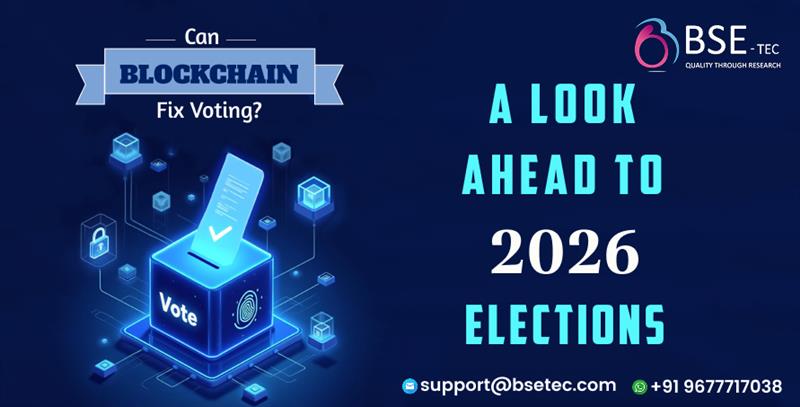Can Blockchain Fix Voting? A Look Ahead to 2026 Elections

As nations grapple with electoral fraud, low voter turnout, and tampering concerns, blockchain voting is emerging as a revolutionary way to bring trust, security, and transparency to democratic processes. With several high-stakes elections scheduled globally in 2026, now is the time to explore how this innovative technology could reshape the future of democracy.
What Is Blockchain Voting?
Blockchain voting leverages the distributed, tamper-proof nature of blockchain technology to enable secure, transparent, and verifiable elections. Votes are recorded as immutable entries on a public or private ledger, making it nearly impossible to alter or erase them. This approach drastically reduces fraud risks and builds trust among voters.
Benefits of Blockchain Voting in 2026
1. Tamper-Proof Voting Records: Blockchain ensures that once a vote is recorded, it cannot be changed or deleted— creating a permanent and transparent record.
2. Enhanced Voter Accessibility: Remote voters, including citizens abroad or those with disabilities, can cast their votes securely via smartphone or computer, expanding democratic participation.
3. Real-Time Results & Auditing: With blockchain voting, results can be audited in real-time without manual counting, minimizing delays and human error.
4. Reduced Electoral Costs: Digital systems can drastically cut costs related to ballot printing, polling stations, and staffing.
There are several countries holding elections in 2026
Several key nations are scheduled to hold major elections in 2026. These could serve as proving grounds for blockchain voting initiatives and few countries are expected to board their elections ,
| Country |
| Lebanon |
| Brazil |
| Sweden |
| Ethiopia |
These elections present unique opportunities for governments and tech innovators to explore secure, pilot-scale implementations of blockchain voting systems.
Real-World Examples of Blockchain Voting
Sierra Leone (2018) : Used blockchain to verify votes alongside traditional ballots—an early experiment in transparency.
West Virginia, USA : Military members voted via a blockchain-based app, reducing barriers for overseas voters.
Estonia : A global leader in e-Governance, Estonia uses blockchain to protect its i-Voting system and digital identity infrastructure.
Telangana, India : This Indian state has tested blockchain voting for secure, remote local elections—paving the way for larger-scale adoption.
Challenges of Blockchain Voting
- Digital Divide: Limited access to digital devices and internet in some regions could exclude vulnerable populations.
- Data Privacy: Ensuring vote confidentiality while keeping the system transparent remains a major technical challenge.
- Regulatory Barriers: Many election laws are not yet equipped to govern blockchain voting technologies.
- Public Trust: Voters must understand and trust the system—requiring strong awareness campaigns and user-friendly design.
The Future of Blockchain Voting: 2026 and Beyond
As blockchain voting technologies mature, we can expect to see:
- Hybrid voting systems combining digital and paper ballots
- Increased adoption in local and diaspora voting before national rollouts
- Legal frameworks tailored to govern digital elections
- Stronger voter authentication using biometrics and decentralized identity (DID)
While blockchain voting is not a silver bullet, it offers a powerful tool to strengthen democratic systems in a time of rising voter distrust and digital threats. As we look forward to the 2026 elections, early pilots and innovation could pave the way for secure, accessible, and transparent elections worldwide.
If implemented responsibly—with safeguards, education, and legal clarity blockchain voting could redefine democracy for the digital age
So in most of the countries , governments/nations strive to collaborate with tech companies like BSEtec to implement Blockchain in Voting by following ,
1. Strategic Partnership with Blockchain Infrastructure Providers
* Access reliable Blockchain-as-a-Service (BaaS) tools.
* Ensure compliance with local regulations (e.g., no cryptocurrency operations in China).
* Utilize integrated public and private cloud hosting options.
This foundation allows agencies to focus on the voting app itself—rather than building underlying infrastructure from scratch.
2. Tech Firms as System Creators and Integrators
Such collaborations typically see governments providing social infrastructure (like voter IDs and legal frameworks) while tech partners supply the analytics, architecture, and software.
3. Pilot Projects to Test Feasibility and Create Proof of Concept
Pilot programs allow governments to observe performance, security, and public reception before scaling the system.
4. Biometrics, Digital Identity, and Secure Authentication
Government-led voting projects commonly emphasize identity validation and voter confidence,These layers support both security and compliance with voter privacy and integrity regulations.
5. Auditability, Transparency, and Verifiability
- Auditability: Systems should maintain clear, immutable records of actions and decisions, enabling independent verification of what happened, when, and by whom. This includes traceable logs, robust access controls, and tamper-evident documentation.
- Transparency: Processes and data handling should be openly examinable, with clear explanations of methodologies, data provenance, model capabilities, limitations, and decision criteria. Stakeholders should understand how outcomes are produced.
- Verifiability: Evidence and metrics should be reproducible and independently confirmable. This involves providing verifiable data sources, test results, versioned configurations, and the ability to reproduce experiments and outcomes under defined conditions.
6. Regulatory Engagement & Public Awareness
In summary, government–tech collaborations in blockchain voting are built on complementary strengths,Governments deliver legitimacy, voter services, legal backing, and trust.
Thus,As we approach the 2026 elections, blockchain technology continues to promise improved transparency, security, and accessibility in the voting process. BSEtec’s strengths—deep blockchain expertise, security-first engineering, and a collaborative approach with regulators and election officials—position us to lead responsible, verifiable, and scalable voting solutions. By focusing on secure architecture, privacy-preserving analytics, and rigorous testing, we can help ensure that blockchain-based voting enhances trust, reduces fraud risk, and increases participation in the 2026 elections and beyond as its high time for getting connected with BSEtec.
Did you find this article useful? Let us know by leaving a comment below, or join us on Twitter and Facebook.




